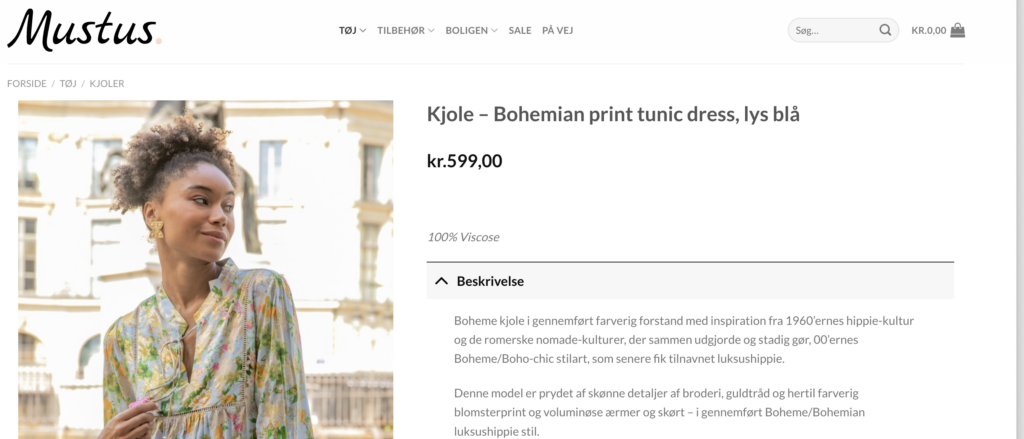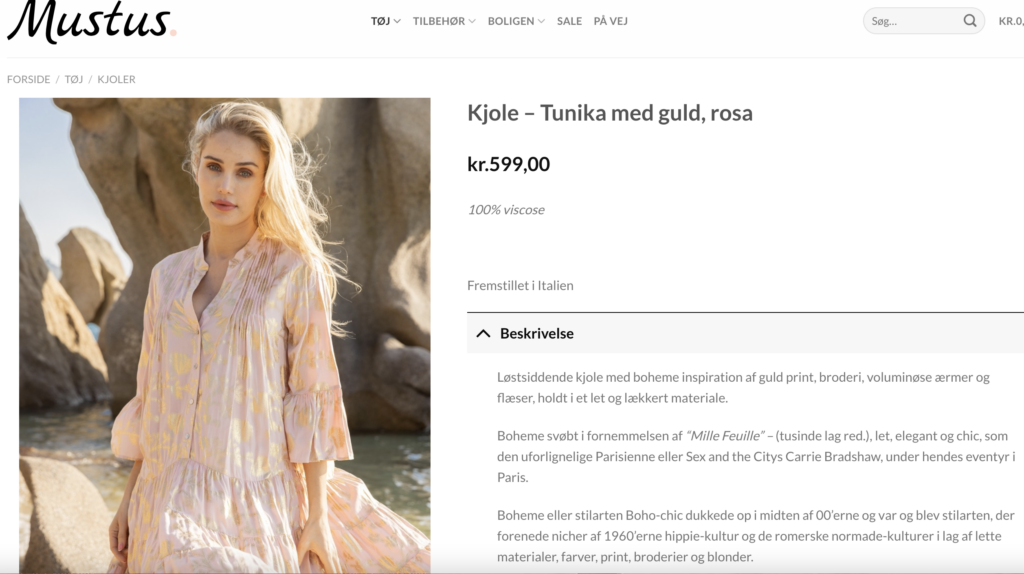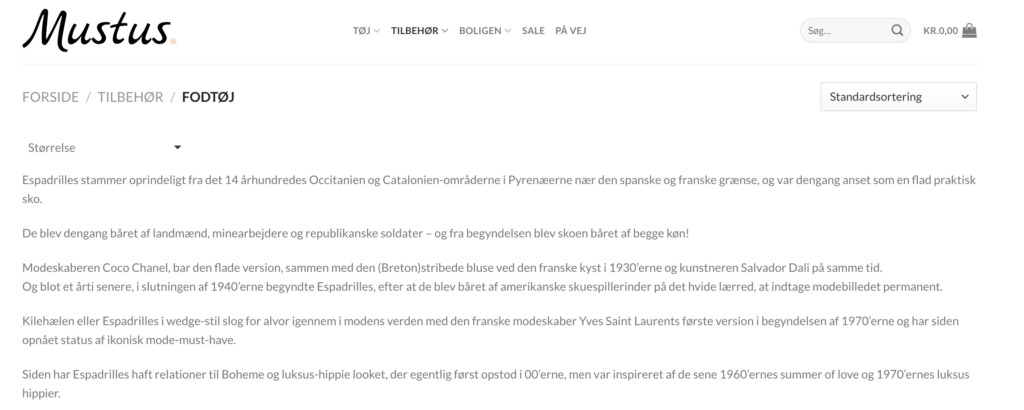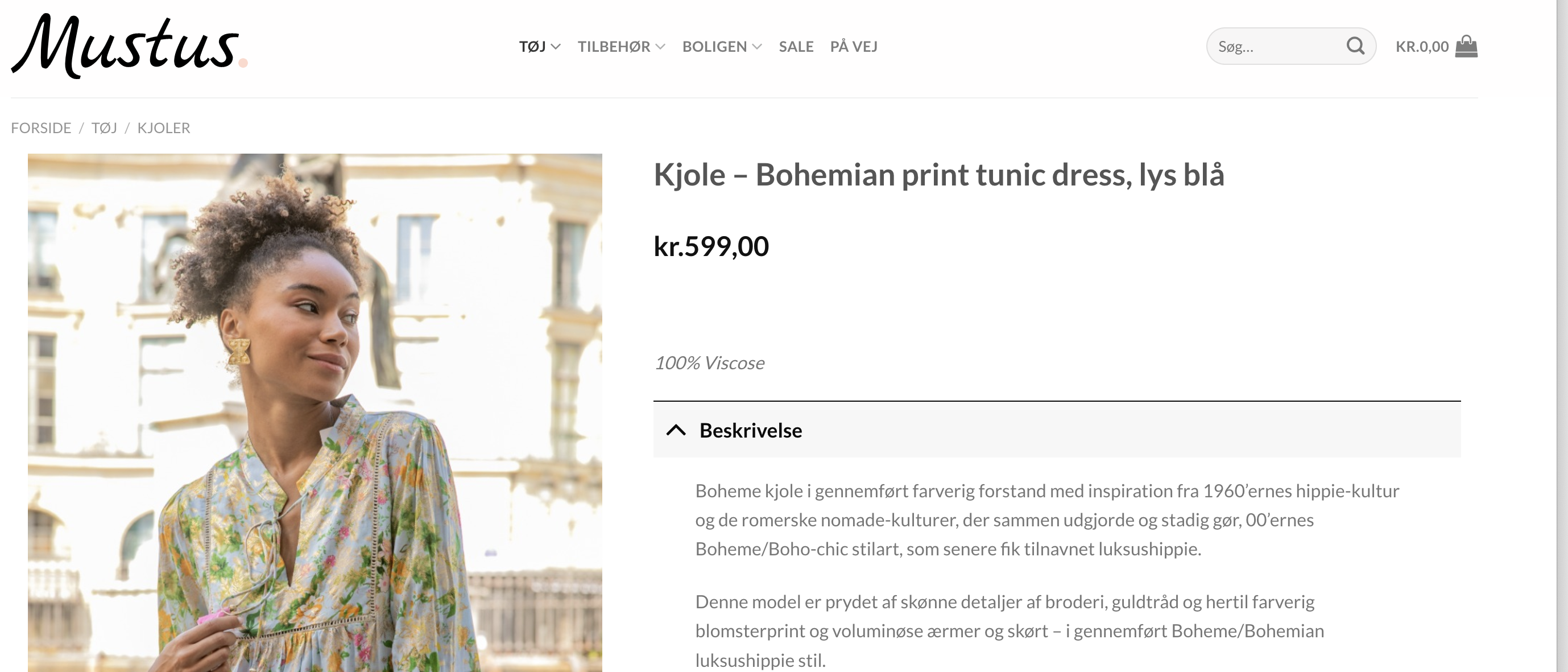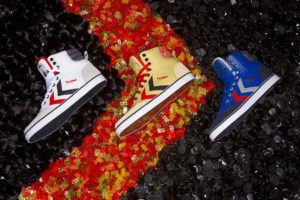Tekstforfatning til Webshoppen Mustus – Tekster i form af; Produktbeskrivelser, tekster om og med beklædningens/modens historie, i større eller mindre omfang.
Modehistorien bliver fortalt med lidt om hippielooket, Bohemian/Boho-Chic og sandalerne Espadrilles, der forenes med den uforlignelige Parisienne og de eventyrlige “Mille Feuille” – Et tusinde lag, i modemæssig sammenhæng.
Washy kjole
Løstsiddende kjole med boheme inspiration af guld print, broderi, voluminøse ærmer og flæser, holdt i et let og lækkert materiale.
Boheme svøbt i fornemmelsen af “Mille Feuille” (tusinde lag red.), let, elegant og chic, som den uforlignelige Parisienne eller Sex and the Citys Carrie Bradshaw, under hendes eventyr i Paris.
Boheme eller stilarten Boho-chic dukkede op i midten af 00’erne og var og blev stilarten, der forenede nicher af 1960’erne hippie-kultur og de romerske normade-kulturer i lag af lette materialer, farver, print, broderier og blonder.
Perfekt til storbyferien eller sommeraftenen i godt selskab
Washy Dress
Loose-fitting dress with a bohemian inspiration of gold print, embroidery, voluminous sleeves and ruffles, held in a light and delicious material.
Bohemian wrapped in the feeling of “Mille Feuille” know as a thousand layers, light, elegant and chic, like the incomparable Parisienne or Sex and the City’s Carrie Bradshaw, during her adventures in Paris.
Boheme or the style Boho-chic appeared in the mid-00s and was and became the style that united the niches of the 1960s hippie culture and the Roman normed cultures in layers of light materials, colors, prints, embroidery and lace.
Perfect for a city break or summer evening in good company
Kjole – Hør skjortekjole, hvid (blomsterprint)
Lækker, chic og casual skjortekjole med foråret og sommerens klassiske blomsterprint i farverig forstand, der henleder tankerne på 1400-tallet fine japanske kimonoer med blomsterprint.
Skjortekjolen kan defineres beklædningsgenstanden, der i ét forener det maskuline univers med det feminine – En sammensmeltning af den klassiske herreskjorte og den fine feminine kjole.
Det fortælles at de tidligste spor af en skjortekjole, kan spores tilbage til det 19. århundrede, hvor kvindernes voluminøse skørter eftersigende kunne have inspiration af den klassiske herreskjorte som overdel – dog båret udenpå korsettet og/krinolinen på denne tid.
Hvor tids version af skjortenkjolen, vil derimod nok nærmere have relationer det 20 århundrede, hvor den fra 1930’erne har domineret fra tid til anden. Været gennemført chic, klassisk, feminin, stilet, taljeret og eller afslappet. Inspireret af hvert årti 1930’erne, 1940’erne, 1950’erne, 1960’erne, 1970’erne og/eller vor tids mere casual og til tider oversized.
Linen shirt dress, white with floral print
Gorgeouschic and casual shirt dress with the spring and summer seasons classic flower print in a colorful sense, which brings to mind 15th-century fine Japanese kimonos with flower prints.
The shirt dress can be defined as the garment that unites the masculine universe with the feminine – A fusion of the classic men’s shirt and the fine feminine dress.
It is said that the earliest traces of a shirt dress can be traced back to the 19th century, when women’s voluminous skirts, could be inspired by the classic men’s shirt as a top – although worn over the corset and/crinoline at this time.
The period version of the shirt dress, on the other hand, will probably have closer relations to the 20th century, where from the 1930s it has been a dominating opart of women’s fashion, from time to time.
Perfectly chic, classic, feminine, stylish, fitted and or relaxed.
Inspired by each decade the 1930s, 1940s, 1950s, 1960s, 1970s and/or the more casual and sometimes oversized of our time.
The story of the Espadrilles
The Espadrilles have their origin in the 14th century Occitan and Catalonia regions of the Pyrenees near the Spanish and French borders, and were then considered a flat practical shoe.
The fashion designer and couturier Coco Chanel, wore the flat non healed version, with the Breton striped blouse on the French coast in the 1930s and the artist Salvador Dali wore exactly the same, at very the same time.
A decade later, at the end of the 1940’s, the Espadrilles began to enter the fashion scene, after they were worn by american actors in movies.
At that time, the shoe, was mostly worn by farmers, mineworkers and republican soldiers:
And from the beginning, the shoe was worn by both genders!
The wedge heel or espadrilles in with a wedge style heel really broke through in the world of fashion with the French fashion designer Yves Saint Laurent’s first version, during the early 1970s.
The shoe have since achieved the status of an iconic fashion must-have and since then, Espadrilles have had relations with the Bohemia and the luxury hippie look, which actually first arose in the 00s, but was inspired by the late 1960s summer of love and the luxury hippies of the 1970s.
The name Espadrilles comes from the Catalan word “Espardenya”, which refers to the native southern European plant, Esparto grass, which is woven into Espadrilles.
